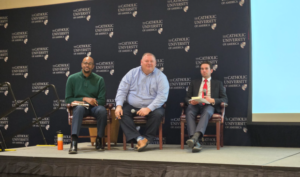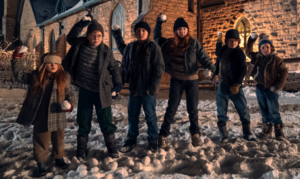Rebuilding America’s Military Project: US Army

Lieutenant General Thomas W. Spoehr spoke at the Heritage Foundation last Friday. Courtesy of C-SPAN
By Katie Hoban
Over the past decade, the United States Army has had to adapt to multiple changes in its structure. From tactics to machinery, certain Brigades to technology, the Army has made advancements to “modernize” itself. Last Friday, retired Lieutenant General Thomas W. Spoehr spoke at the Heritage Foundation in regards to Army Modernization.
The Heritage Foundation, a nonprofit conservative think tank, hosted a Q&A with Mr. Spoehr who issued the “RAMP” Project memo to help the Army modernize itself in certain fields. He has also written security articles with The Daily Signal as a commentator.
Spoehr served in the US Army for over thirty-six years with equipment modernization and talent management with Army Warrant Specialist and Officers. He looked for man power and organizations within the Army. Spoehr expertise is in national defense policy and strategy.
Sphoer’s report went over future challenges, such as world environment changes and how the government cuts the Army’s budget every 15 years.
“This makes it difficult because you can’t protect service and modernize [the Army],” said Spoehr.
Spoehr went over the Army’s successes and failures along the way of modernization. The Pentomic Division by Eisenhower, a division used to fight if a nuclear war broke out, and the Active Defense, in regards to the first steps towards cybersecurity, were some of the biggest modernization failures because they were “not what the army needed to be.” The Iraq movement and Task Force Modulation were examples of the Army’s successes of pushing the branch into the 21stcentury.
The main focal points of the report focused on what needed high attention. The army puts their branch generals where they have no experience and throws people into the deep end in hopes that they figure it out. The term, “Group-Think,” contributes to the bad decisions made in the Army as fear of speaking up casts a dark shadow over the branch. If Congress gets wind of dissent, funding goes down.
The Brigade of the army is not the most used unit anymore, according to Spoehr, and that “[the Army has] to reinvigorate tasks for appropriate levels”. The new modernization the Army is aiming for is not in the Brigade format anymore. Moving forward, the Army will be aiming to utilize more aerial forces such as drones and fighter aircraft.
Congress is not completely on board either, with Spoehr stating, “it only gets harder.” The Branch also needs more soldiers in order to modernize itself, which comes with an array of problems: more boots means the Army needs more money, but with more soldiers, there is less money to fund the modernization project.
Leaders also need to focus on modernization; Spoehr stressed that officials “got to devote time” to make the revamping of the United States Army work. Officials need to stay in their modernization project for 2-4 years to train, prepare, and keep up the improvements.
Overall, the feedback on Spoehrs report has been positive, and The Chief of Staff of the Army and the Secretary of the Army even gave high regards of the report.








